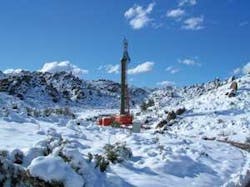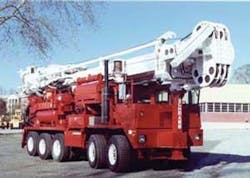The high season for Canadian drilling should begin now, but many Canadian operators plan to scale back operations. Depressed commodity prices, increased operations costs, and the new Alberta royalty program all hurt drilling activity north of the US border.
Due to commodity price (and industry) pressure, the Alberta government recently announced a transitional, lower royalty for new wells drilled after Nov. 18, 2008, but this will probably have little effect on operators’ plans to drill (OGJ Online, Dec. 17, 2008).
In response to a Nickle’s Energy Group poll, 51% of respondents said their companies would still “decrease its capital budget for drilling in Alberta in 2009 because of low commodity prices, weak capital markets and higher Alberta royalties.”
In November and December, Canadian Natural Resources, EnCana Corp., Imperial Oil, Petro-Canada, Royal Dutch Shell PLC, and Suncor Energy announced delays of various projects in Canada. Some processing projects were canceled outright.
Top Canadian drilling rig operators in December were EnCana (43 rigs), Husky Energy Inc. (30), ConocoPhillips Canada Ltd. (27), Talisman Energy Inc. (23), and Shell (18), according to Nickle’s Rig Locator.
CAPP forecast
The Canadian Association of Petroleum Producers represents more than 95% of Canada’s upstream oil and gas industry. In November, Greg Stringham, vice-president of markets and fiscal policy, presented CAPP’s 2009 outlook and drilling and investment forecast. He said Canada is the world’s third largest natural gas producer and seventh largest crude oil producer, but production has been affected by the downturn in global oil prices, new supply discoveries (North American shale gas; Bakken oil), financial market instability, and royalty changes in Alberta.
Stringham noted a regional shift in focus in Western Canadian Sedimentary Basin (WCSB) provincial Crown land sales from 2007 to 2008. Investment in British Columbia and Saskatchewan surged 400-500%, while Alberta investment dropped or remained flat.
Western Canada natural gas production continues to decrease. This averaged 15.8 bcfd in 2008, down from 16.4 bcfd in 2007 and 16.8 bcfd in 2006.
CAPP is forecasting $43 billion (Can.) in Canadian oil and gas investment spending in 2009, down from about $50 billion/year in 2006-07. In particular, spending on oil sands is expected to drop about 20% to $16 billion in 2009, and spending in the WCSB will drop to $25 billion from about $29 billion spent in 2008.
About 16,000 wells were drilled in western Canada in 2008; CAPP expects only 14,700 wells in 2009, an 8% decrease.
CAODC forecast
The Canadian Association of Oilwell Drilling Contractors estimates 14,325 wells will be drilled in western Canada in 2009, based on 9 drilling days/well and rather high commodity prices: $99/bbl (Can.) for WTI crude and $7.30/Mcf (Can.) for AECO gas, about double the prices in mid-December 2008.
CAODC sees an active fleet of 880 rigs and 55% utilization in first-quarter 2009, dropping to 17% in second quarter, rising to 40% in third quarter, and 45% in fourth quarter, for a average 39% utilization in 2009. CAODC puts 2008 utilization at 42%.
Trends
Operators and drilling contractors reported significant cost inflation in materials, fees, and labor rates.
Calgary-based Ziff Energy Group announced two major studies at the end of 2008. The 15th edition of its Western Canadian Sedimentary Basin study assessed upstream operating costs and production reliability, based on 32,500 producing wells in 300 fields. The study base produced 4.9 bcfd natural gas and 340 million b/d of conventional oil.1
Ziff found that weighted average unit costs increased 6% to $0.97/MMcf-equivalent in gas fields and increased 11% to more than $11.70/boe in oil fields. The main drivers were increased service and energy costs. Fig. 1 shows the relative significance of various factors affecting average operating costs.
Ziff announced the launch of a new SAGD drilling and cost benchmarking study in September 2008.2 The study will analyze and benchmark the cost of 160 SAGD horizontal well pairs and more than 2,000 core wells.
Scott Jones, SAGD study project manager, told OGJ that Ziff is currently gathering data and working on study design and expects to complete the work in spring 2009. Study participants include ConocoPhillips Canada, Nexen Inc., Chevron Canada Ltd., Shell Canada Energy, Connacher Oil & Gas Ltd., StatoilHydro Canada Ltd., and Total E&P Canada Ltd.
Ziff noted that Alberta oil sands production has grown 160%, to 0.6 million boe/d over the 6-year period 2003-09, and Ziff analysts expect it to increase 120% to 1.3 million boe/d from 2009 to2015. Conventional oil production in western Canada will drop to 1 million bo/d in 2015 from an estimated 1.3 million bo/d in 2009.
Canadian oil sand producers launched a new website in June 2008 to cover environmental and social impacts of development through media stories, opinion pieces, and a public discussion forum (www.canadasoilsands.ca/en/).
Reorganizations
Various Canadian companies are reconsidering plans to split or spin off IPOs.
During a 2009 budget conference call on Dec. 11, Randy Eresman, EnCana Corp.’s president and chief executive officer, said, “Depending on market conditions, the company may divest between $500 million and $1 billion of noncore assets. If prices are weak in 2009, we expect to invest less and sell fewer noncore assets. If prices strengthen, we expect to invest more and sell more noncore properties.”3
Marathon Oil Corp. Pres. and Chief Executive Officer Clarence P. Cazalot Jr. said on Dec. 11 that the company continues to evaluate a split of its assets and operations into two independent companies. Marathon’s oil sands mining headquarters is in Calgary.
Market volatility
A common problem in this industry is that short-term price volatility threatens long-term strategic planning. Increasing production generally involves large capital expenditures and is hampered by a long time lag.
When operators succeed in their initial exploration programs, it generally leads them to increase the number of rigs in order to drill and define reserves more quickly. Drilling results become critical to determine or refine land and lease strategy and to enhance shareholder communications. Continued drilling, however, depends on oil and gas prices remaining above proprietary economic thresholds under which exploration would stop or significantly slow.
In some areas, natural gas prices are beginning to fall below threshold prices for operators to proceed with project development. Oil prices falling to $40/bbl (US) has certainly affected the pace of heavy oil and bitumen projects in northern Alberta.
Price corrections do not necessarily have a significant impact on exploration programs, but they do affect development drilling and production infrastructure. The oil price surge in 2007-08 spurred new projects and investments in upgraded rig fleets and infrastructure. The current downturn suggests that some projects will be delayed and rigs sidelined as long-term, high-cost investments are sidelined.
Canadian scale-backs
On Dec. 15, CAPP announced that it scaled back its oil sands forecast. Oil sands now account for nearly 45% of Canada’s total oil production (www.capp.ca). The organization expects Canadian oil sands production to reach 2.37 million bo/d in 2015, down nearly 400,000 bo/d from its annual forecast made in June. Greg Stringham, CAPP’s vice-president of markets and fiscal policy, said, “There’s relatively little change from our summer report through 2012, but there’s a significant drop in 2012-15.”
On Dec. 11, EnCana Corp. announced a $6.1 billion (US) capex budget for 2009 with the flexibility to “adjust investment by $500 million, up or down, depending upon how economic circumstances unfold during the year.”3
Eresman said the company would apply a higher level of scrutiny to investment decisions through 2009, wary of current market uncertainty. The company will spend about $4.5 billion (60% of 2009 forecast cash flow) to maintain natural gas and oil production at 2008 levels, directing the money to “key resource plays.”
EnCana will cut spending about 13% in Canada overall, to $2.3 billion in 2009 from $2.6 billion in 2008. It will increase spending in the Maritimes, however, staying on plan for Deep Panuke development.
Company managers said EnCana is running about 20 rigs in the Canadian foothills, including 15 deep rigs and 5 shallow rigs, all fit-for-purpose, and will continue with these through 2009. It also has 15 rigs on the Canadian plains but will average 5 rigs there through 2009, with a max of 10-15 in the winter drilling season. There are 10 rigs drilling multileg, horizontal wells at Weyburn, a sour crude oil play in southeastern Saskatchewan. In Alberta, EnCana will continue to use one or two rigs to drill SAGD wells at Christina Lake and at Foster Creek.
Petro-Canada also announced reduced budgets for 2009 on. Dec. 11, citing low commodity prices and financing uncertainty.
It will spend about $4 billion (Can.) in 2009, down from $6.1 billion in 2008. Pres. and Chief Executive Officer Ron Brenneman said Petro-Canada plans to drill about 12 wells internationally in 2009, including 3 wells in Alaska, 3-4 wells in Libya, 3-4 wells in the North Sea, and 1 on the east coast. This is down from 17 wells in 2008. It will not be drilling in Trinidad in 2009.
Major Drilling
In early December 2008, Major Drilling Group International Inc., based in Moncton, NB, reported results for its second-quarter of fiscal year 2009.4
Major Drilling has field operations and offices in Canada, the US, South and Central America, Asia, Africa, and Australia, with about 4,500 employees worldwide. The company says it provides “all types of drilling services including rotary, directional, reverse circulation, surface and underground coring, directional, reverse circulation, geotechnical, and environmental drilling, primarily to the mining industry.” It focuses on specialized drilling services due to “intense competition in conventional drilling, particularly in Canada.” The company says it can move rigs from oil and gas back to mining work when petroleum prices are low.
Rob Newburn is vice-president of operations for Major Drilling America Inc., based in Salt Lake City. The company’s rigs and staff have evolved from Tonto Drilling Services, sold to Dynatec Mining in 1988 and then sold by Dynatec to Major Drilling in 2005. It now has about 200 employees in the US.
The company had five “energy-capable” rigs operating in the US by yearend 2006, focused on shallow gas drilling. It also does preset work, drilling and casing tophole sections to 4,000 ft, and provides coring services out of its Utah office (Fig. 2).
Major Drilling America increased the size of its US fleet and had eight rigs drilling coalbed methane last winter, 2007-08.5 The drilling fleet includes 760-hp Schramm T130XD Rotadrill rigs: carrier-mounted drill rigs with telescoping masts that handle Range III casing and can pull 130,000 lb (Fig. 3).
Major Drilling International added 61 new rigs to its fleet and acquired two South American assets during fiscal 2008:
- Exploration drilling company Harris y Cia Ltda., a specialized drilling firm active in northern Chile; 11 rigs; $23.9 million.
- Assets of exploration drilling company Paragon del Ecuador SA; 7 rigs; $6 million.
Adding new staff and rigs requires changes in training. Major Drilling employees in Mexico produced an orientation video that illustrated the correct way to work around drills and covered important safety practices, according to Newburn. It was augmented by 12 other training videos to establish a common skill level for all employees. This video library is now the planned standard for all Latin American operations.6
Expectations
Although the economic downturn continued to deepen at press time, the outlook for the oil industry remains unclear. The International Energy Agency offers a positive outlook, predicting that demand will be up in 2009.
Price fluctuations are nothing new in this industry, however, and oil companies will continue to explore and develop oil and gas resources, although at a more measured pace. They will continue to search out and employ new technologies to work more quickly and efficiently.
Innovative companies will devise intelligent approaches to optimizing data acquisition and processing. Economies of scale will encourage collaboration with partners and suppliers. Management will have to work hard to set appropriate analyst and stockholder expectations and manage projects and processes to defer avoidable costs.
We can probably expect to see further delays or cancellations of newbuild rig programs.
EnCana’s Eresman summed up the company’s outlook on Dec. 11, “With respect to cost inflation, we expect consistent downward pressure throughout 2009 with greater effect later in the year. Short-term impacts are expected to be offset by a number of factors including existing commitments and supplier inventory as well as moderate increases in labor rates. We do not expect our more measured pace in 2009 to have a significant impact on the long-term development of our key resource plays.”
References
- “Canadian Operating Costs Continue to Soar,” annual operations analysis, Ziff Energy Group, Nov. 25, 2008, www.ziffenergy.com.
- “New SAGD Drilling Benchmarking Study Launched,” Ziff Energy Group, Sept. 23, 2008, www.ziffenergy.com.
- EnCana Corp. 2009 budget conference call, Dec. 11, 2008, www.encana.com.
- “Major Drilling Reports Second Quarter Results,” press release, Dec. 8, 2008, www.majordrilling.com.
- Ettling, Greg, “The Major Evolution Continues—Part 1,” National Driller, Jan. 2, 2008, www.nationaldriller.com.
- 2008 Annual Report, Major Drilling Group International, www.majordrilling.com.




